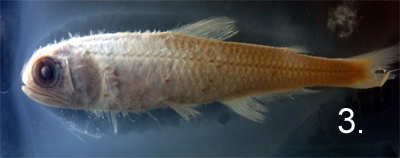
SUPERORDER SCOPELOMORPHA
Scopelomorphans are a group of around 560 species preying on fish and invertebrates in deep sea environments in all the world’s oceans. Like stenopterygians, many are surprisingly abundant and many have luminous organs. Like stenopterygians they were considered too ugly for the display.
ORDER AULOPIFORMES
This order of 190 species includes the lizard fish and the spider fish.

Bathypterois dubius, a spiderfish (Family Ipnopidae). Spiderfish are small bottom-dwelling predators that feed on mysids and copepods which live within a metre of the sea floor. Spiderfish stand on the sea-floor, facing into the current, on the elongate rays on their caudal and pelvic fins and grab passing zooplankton. Their eyes are tiny and they probably detect their prey with long independent rays of the pectoral fins. They may reach 20 cm, This specimen is 18 cm long.
ORDER MYCTOPHIFORMES
This order derives its name from the greek for nose and serpent.
Family Myctophidae. The 300 species of carnivorous, blunt-headed lantern fish live in depths of 300-1200 m by day; many species move upwards at night. Many are speckled with small luminous photophores and concentrations of larger light organs that signal their gender. Small fish, rarely reaching 30 cm, they are remarkably abundant and are heavily preyed upon by many marine mammals.
 |  |
 | |
1. Ceratoscopelus maderensis, Lantern fish, 7 cm long.
2. Diaphus rafinisquii, White-spotted lantern fish, 7.5cm long.
3. Myctophum punctatum, Spotted lantern fish, 8 cm. This specimen was collected by the Discovery Expedition on 11th May 1906.






